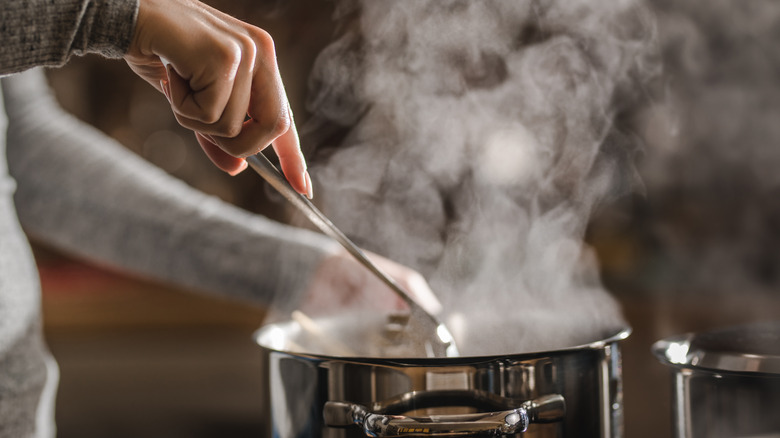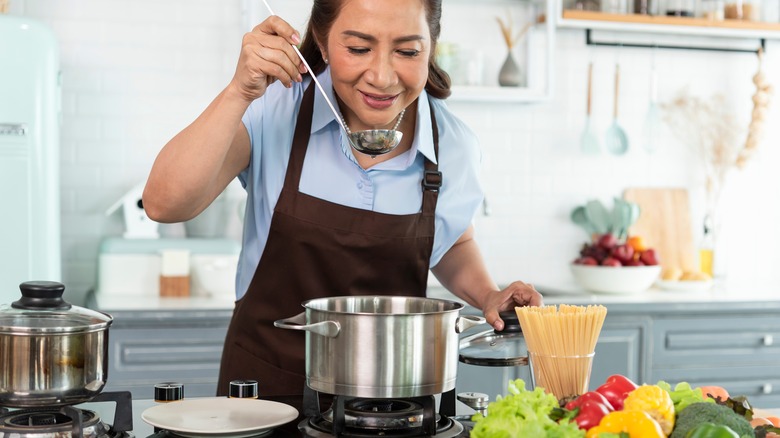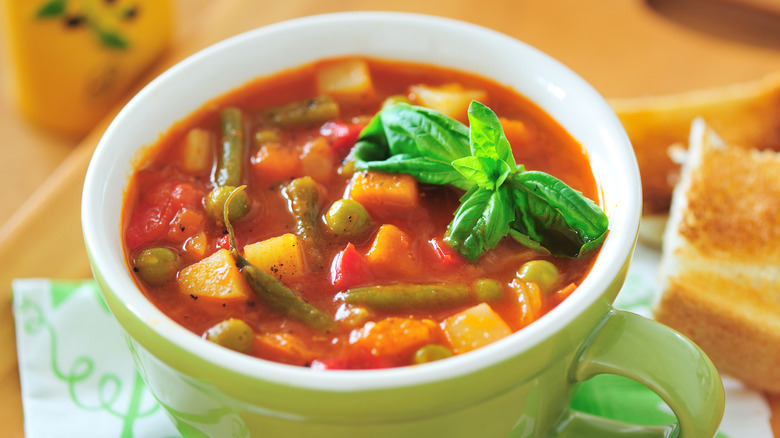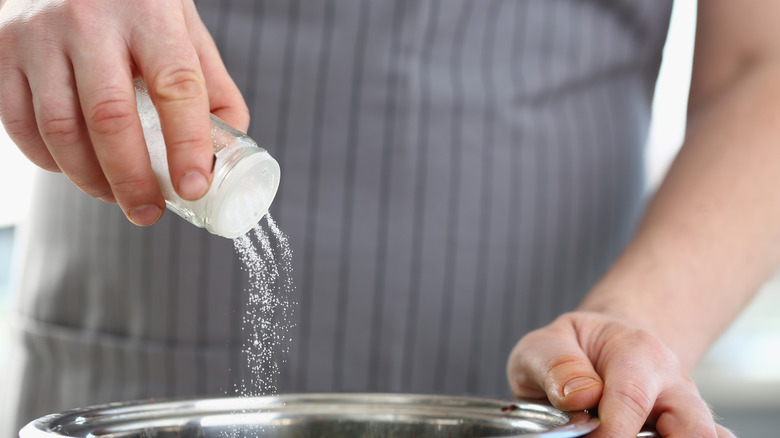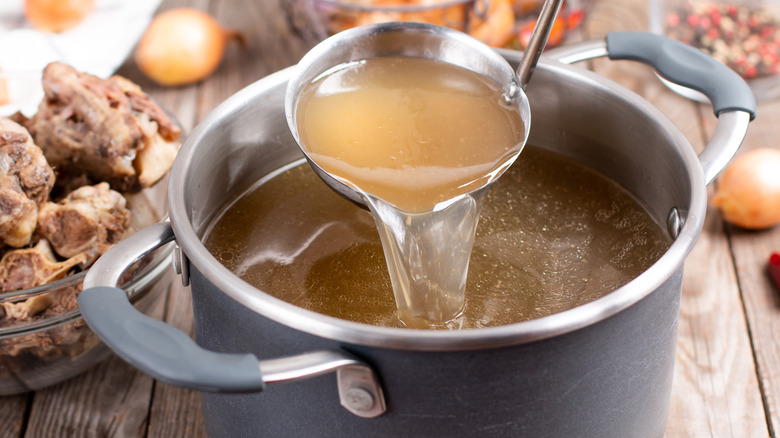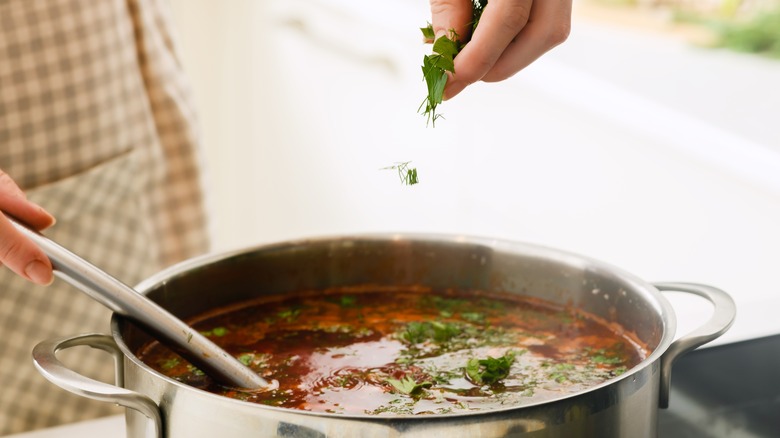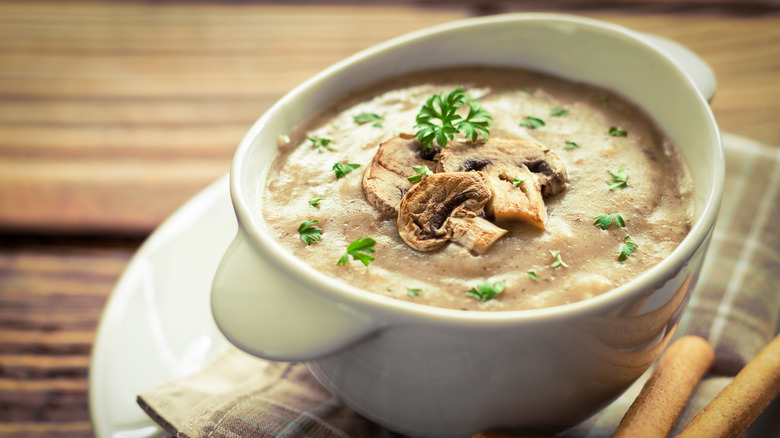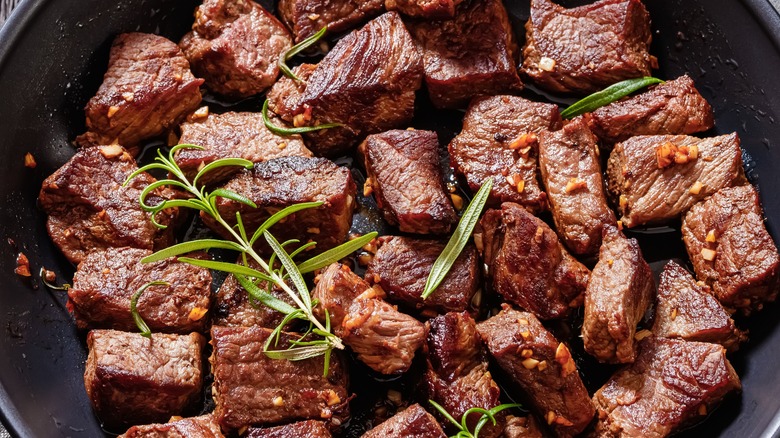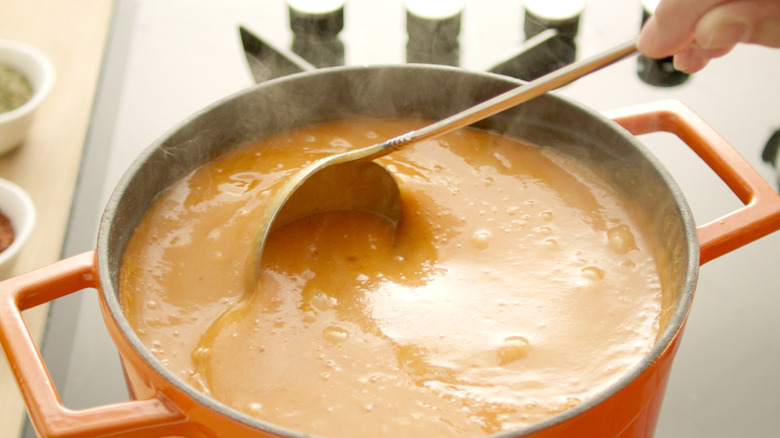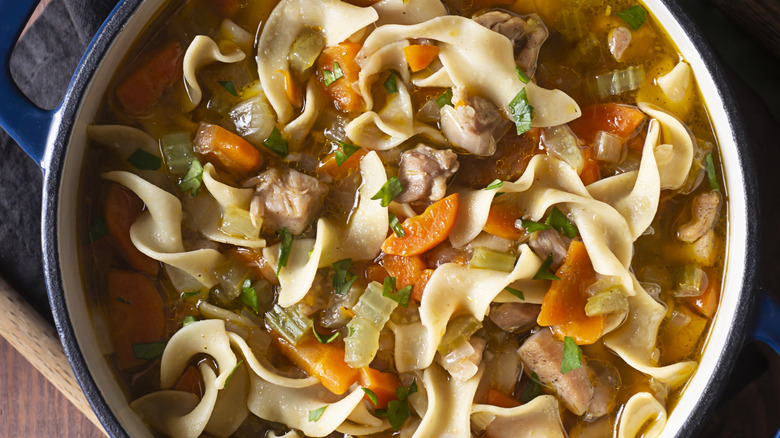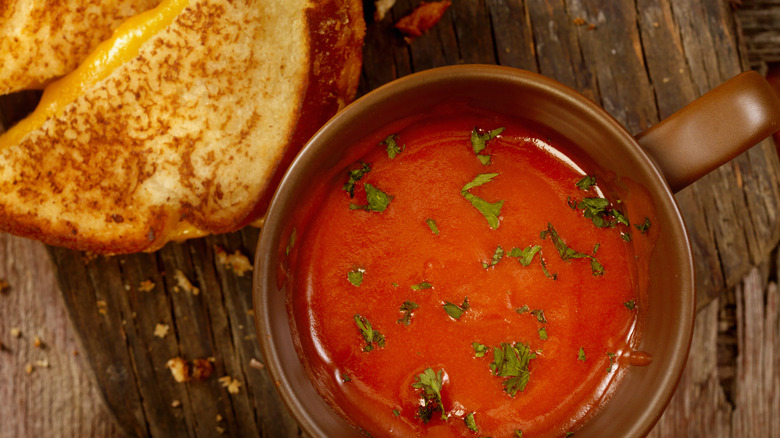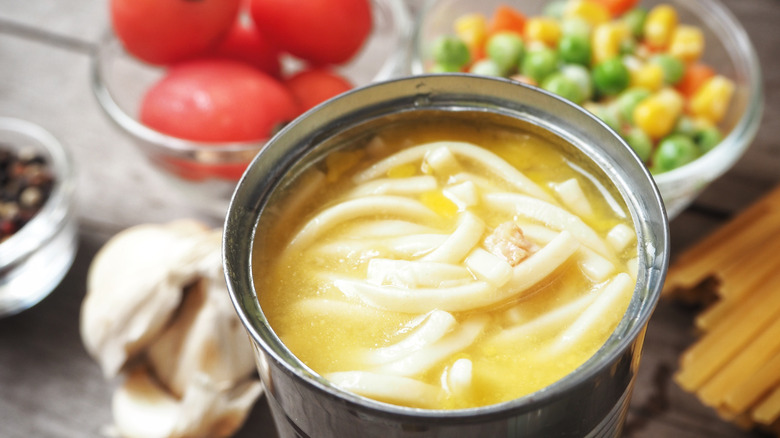12 Mistakes To Avoid When Making Soup
Minestrone. Clam chowder. Gazpacho. Miso. Borscht. Goulash. Good ol' chicken noodle. When it comes to a warming, comforting bowl of homemade soup, the options are truly limitless.
The dictionary defines soup as any "liquid food made by boiling or simmering meat, fish, and vegetables." The classic dish is not only one of the most beloved foods around; it's also one of our very oldest. Historians trace the making of soup back to at least 20,000 B.C., and it's believed to be even more ancient than that. Some folks theorize that the early Neanderthals were the very first to make soup. They are said to have dug pits, lined them with animal skins, filled those pits with water, meat, and produce, and then dropped in hot rocks from a nearby campfire to "cook" the soup. Talk about a rustic, DIY dish!
While we've definitely come a long way since then, even with this very basic and simple dish, there are mistakes to avoid when making soup. There is an art to creating soup, after all. It can be more complicated than it seems. Whether it's the ingredients you're choosing, the way you're pairing them together, or your soup-making skills in general, culinary mishaps abound. But we're here to help. Pull out a pot, grab some veggies and a bit of stock, and get ready to start cooking like a pro as you kiss these common soup-making blunders goodbye forever.
Not tasting as you go
Rule number one of making soup is that you should always taste your soup as you go. The beauty of soup is that it is one of the most forgiving, adaptable, and beginner-friendly foods out there. You don't have to worry about doughs rising, crusts forming, sauces breaking or anything curing, fermenting, or tempering. You just have to make a delicious bowl of food you're excited to eat. The secret to doing this successfully is taking frequent bites of your soup as you prepare it, including after adding ingredients or after it has been simmering for a while.
If you like what you taste, great — you're doing a good job! If you don't like what you taste, that's good too because you now have a chance to fix it before the soup is done and you serve it. As you carefully sample your soup every five minutes or so, look for a balance of flavors — you should taste a harmonious blend of sweet, salty, sour, and umami. Consider the salt level, mix of heat and spices, and the overall texture and mouthfeel of the soup as you roll it around in your palette.
Also, think about aroma and consistency. Try to ensure you have a well-thought-out blend of ingredients that all work together well without anything standing out negatively. Then, address any issues you spot, adapting your recipe as needed — and tasting after each change to make sure you're on the right track.
Overcooking your veggies
If you're cooking tomatoes for tomato soup or broccolini for a wonderful, creamy bowl of broccolini-spring onion soup, then, by all means, cook those veggies down until they turn into absolute mush — you're going to run through a blender or puree them anyway so they don't need to be firm. But for any other soup — from split pea to vegetable to a hearty potato-filled stew — you want your produce to have some thickness and consistency. You want to know what you're eating. And when you overcook your vegetables, that just isn't possible.
To avoid overcooking vegetables when making soup, always add ingredients in stages based on cooking time. Start with root vegetables like carrots and potatoes as some of the first things you add to your pot, and add more delicate items like leafy greens nearer the end of cooking. Cut all your ingredients into uniform sizes as well. This helps to ensure even cooking since smaller cut items will cook faster than larger cuts.
Use high heat sparingly, avoid prolonged simmering, and consider only partially covering your pot instead of covering it completely with a lid. This allows steam to escape and helps to keep temperatures more veggie-friendly.
Finally, consider cooking certain ingredients (like peas, corn, and asparagus) separately and adding them to your pot later versus trying to cook them in the soup's broth. This is one more easy way to ensure they will be perfectly cooked and not too crisp or mushy.
Using too much salt
It's easy to have a heavy hand when adding salt to different foods. But soup is especially prone to over-salting. Vegetables and grains absorb salt as they cook, and liquids reduce and become more concentrated as the soup comes together. It's no wonder we all sometimes end up with a pot of soup that's far saltier than intended — even if you feel like you didn't add that much salt to your soup to start with.
To keep any soup from becoming uber salty, avoid adding any salt to the soup at the start of the cooking process. Leave that for later on as the soup is nearing completion. Consider using lower-sodium broths, canned ingredients, and other prepared foods when possible. And opt for acidic ingredients like tomatoes, vinegar, or citrus or fresh herbs, spices, and aromatics. Each of these powerhouse ingredients adds flavor and richness to the soup without the addition of any unwanted salt.
Finally, when it's time to add salt to your soup, proceed with caution. Start with less salt than you think is required, taste the soup, and then add more if you really need it. Remember: a little goes a long way. While table salt absorbs quickly and might be your go-to option, sea salts, and smoked salts are more delicate and pack additional flavor that can make soups seem even more decadent. Avoid large crystals of salt, which will dissolve slowly and can become more intense as your soup simmers.
Not using homemade stock
If you want to make a delectable bowl of soup, go the extra mile and prepare some homemade stock. It's far easier than you might think, and it goes a long way in making a "meh" bowl of soup into something truly outstanding.
Stock is quite literally the liquid left after you've boiled any combination of meat, bones, or vegetables in water for a prolonged period. You can boil water with chicken or turkey bones to make poultry stock. Or, boil some water and a leftover ham bone to make an incredible homemade ham hock broth.
Many delicious soup broths can also be 100 percent plant-based. Use the ends and peels from carrots, radishes, and beets to make a root vegetable broth. Boil water and celery pieces to make a celery-forward broth. Or, take the leftover "hard" ends you might have otherwise trashed after preparing fresh asparagus and create a vibrant asparagus stock.
Regardless of the type of stock you're making, the process is essentially the same. Take about one pound of meat, bones, or produce and put it in a large stock pot. Then, fill the pot with 2 quarts of water. Bring everything to a boil, reduce the heat, and let simmer for at least 30 minutes. The longer the stock cooks, the more flavorful your soup will be.
Forgetting to use spices to build layers of flavor
After your choice of broth, the herbs and spices you use to make any soup may just play the most essential role in determining how successful your recipe ultimately is. Skip those herbs and spices, or choose poorly, and your soup will suffer — there's no debating this common mistake to avoid when making soup.
To masterfully use herbs and spices when preparing any soup, always use fresh ingredients whenever possible. Herbs like basil, rosemary, thyme, and cilantro pack immense flavor and are perfect for a wide range of soups. Just dice 1 to 2 tablespoons and throw them into your broth to let them work their magic.
Building on those fresh herbs, add layers of flavor with dried spices like cumin, turmeric, garam masala, and chili powder. You can also use uncommon cooking spices, like nigella or urfa biber, to impress your soup with more unique flavors. Start with 1 to 2 teaspoons, mix that spice in, and then taste your soup. Then, add more as needed.
Balance is essential. You don't want to overwhelm your soup with too many competing flavors. So pick a couple of favorite herbs or spices that complement each other well and use them as your soup's base layer of flavor. Then, help those flavors shine with the addition of something sweet, spicy, or even earthy to perfectly round out your soup's final, overall flavor profile.
Adding dairy too early
Many soups, from New England clam chowder to potato leek to lobster bisque, include some form of dairy as a key component. But adding that milk or cream to your soup too soon can be a terrible blunder we all fall prey to. When you add dairy to soup before you should, you increase the risk of a range of issues including curdling, overcooking, separation, and even scorching.
To keep these issues at bay, remember that dairy should always be one of the last ingredients you add to your soup, near the very end of the cooking process. You want to warm it and let it absorb the flavors of the other ingredients in your soup, but that's it. It should never simmer on the stove for a prolonged period. (Some tomato soups or chowders are exceptions to this rule — you do add your dairy earlier in the cooking process. But these soups should always be cooked over very low temperatures to help to protect them from burning.)
When adding dairy to a hot soup, always temper it first. Add a small amount of the warm broth to the cold milk or cream and stir well. This helps the dairy adjust to the warmer temperature without curdling. You should also always reduce the heat your soup is cooking at to low or simmer as you add that dairy, again to help reduce the risk of unwanted reactions.
Boiling instead of simmering
Speaking of simmering, it's not just soups containing dairy that benefit from cooking at a more gentle temperature just below the boiling point (usually around 185 to 205 degrees Fahrenheit). Simmering is ideal for making soup because it allows for slower and more even cooking. It produces tender and well-cooked ingredients that are much less likely to end up overcooked or to break apart within your soup. Simmering also promotes the more gradual development of flavor. It helps soups taste more nuanced and complex — it's the difference between a good soup and a great one.
Boiling, on the other hand, is far more aggressive. It occurs at 212 degrees Fahrenheit and can turn delicate ingredients into mush. It can cause the rapid loss of liquids, making soups thicker than you might have intended. And it makes your soups much more likely to curdle or burn before they're ready to be served.
While a cooking thermometer is the absolute best way to determine whether your soup is boiling or simmering, there are some visual cues you can look for as well that are just as insightful. Typically, when a liquid simmers, it produces tiny bubbles that rise to the surface but do not break. Boiling, in contrast, is much more vigorous. Large bubbles come in rolling waves that break the surface of the liquid. You will also notice considerably more steam and noise when a soup is boiling compared to when it is simmering.
Using meat you haven't drained
Ground beef or turkey, sliced sausages, and cubes of steak and pork are all common soup staples. In most cases, these meats are browned to golden perfection and then added to the broth of your soup. The meat needs to be cooked this way to properly sear and form a crust. If you just cooked it within the soup broth, it wouldn't have that wonderful caramelized flavor that makes meat so tasty.
But when preparing meat to add to soup, there's one crucial thing to always keep in mind. You can't just dump the cooked contents of your skillet directly into the broth of your soup. You need to drain your meat first!
Putting meat that hasn't been drained into soup doesn't just make soup fattier and more caloric (although it does those things, too). It also alters the flavor and consistency of your soup, making it richer and greasier and giving it a potentially weird or unpleasant mouthfeel. That fat can also latch on to spices within the soup. When this happens, and the soup begins to cool, the fat — and flavor — will rise to the soup's surface, creating a sludge at the top of the soup and leaving flavorless broth underneath.
The solution? Always drain (or strain) any cooked meat before adding it to soup. You may even want to blot the meat with paper towels to absorb any additional surface fat before you use it.
Too much stirring!
There are things we all cook, like caramel sauce, custards, or even risotto or polenta, that require nearly continuous stirring. But soup is not one of these foods. In fact, too much stirring is another common soup making mistake that can really ruin a good pot.
When you stir any soup too frequently as it's cooking, you can cause the ingredients in your soup to start to break apart. From potatoes to pasta to rice, this frequent stirring can also promote the release of starches and turn your soup into a hot slush. Finally, too much stirring can make soups cloudy and can cause proteins like fish or seafood to become flaky and almost "dissolve" within your broth.
So, how much stirring is too much? You should stir your soup when adding ingredients or spices and then sparingly after that as the liquid simmers to prevent over-thickening and burning. If you are stirring more than this, you are likely stirring too much.
Putting dry pasta into soup too early
Italian wedding soup, chicken tortellini, and lasagna soup are just a few of the many wonderful soups out there that contain some type of pasta. But regardless of the kind of soup you're making, it's a mistake to add pasta to your soup too early.
Pasta starts to cook and soften as soon as it hits hot water, so it will inevitably become overcooked when you add it prematurely. It will absorb too much broth too soon, becoming soggy and perhaps even losing its intended shape. The pasta's texture will also become overly soft, and it can even start to release starch into the soup, making your broth mealy or cloudy.
Every pasta is different, so the key to avoiding this common mistake is to become hyper-vigilant about whatever instructions are on the package for the pasta you're using. You should be adding pasta to your soup broth near the end of the cooking process. And if anything, as you follow those package directions, give your pasta less time to cook, not more, as it will continue to soften in the hot broth even when it has been removed from the stovetop.
Jumping the gun with your acidic ingredients
Acidic ingredients play an essential role in all types of food. They brighten and balance flavors, cut through richness, and add complexity to a dish's overall taste. This is especially true when it comes to soup. Ingredients like tomatoes, citrus juice, vinegar, wine, and buttermilk all help to give soups a vibrant, sweet, and tart tang.
But as important as these ingredients are to the success of any soup recipe, they also create the potential for a number of different mistakes that can ruin a good bowl of soup — especially if you add them to the dish before you should. Adding acids to a soup prematurely can cause meats to toughen, especially if the soup simmers for a prolonged period. Acidic ingredients also cause veggies to lose some of their flavor over time. They can trigger unusual or unwanted colors in your soup, prevent beans from softening, cause unpredictable flavor changes, and may even cause some ingredients to break down or lose their desired texture, making your soup dense and gummy.
To ensure your acidic ingredients don't mess up your soup in ways you hadn't intended, always add them during the last moments of cooking — or even after your soup has been removed from the stove entirely. Start with a small amount of whatever acid you are using, taste your soup, and then add more if needed. This will promote balance and keep the acids from overpowering the soup entirely.
Not souping up your canned soups
Still can't bring yourself to make homemade soup from scratch? Or are you just too short on time and prefer to pop open a can for the sake of speed and convenience? In that case, the last mistake we all need to avoid when it comes to making soup is perhaps the easiest. Don't just settle for that canned soup as is. Add something to it!
Stir in some freshly chopped herbs like parsley, cilantro, or basil. Grate lemon or lime zest over the top of the soup to give it a citrus bite. Throw some croutons or grated cheese on top. If you have a smidge more time, sauté some freshly minced garlic and stir that into the soup. Or poach an egg and place it in the middle of the bowl for you to dig in.
A drizzle of sriracha or hot sauce, some freshly diced avocado, a dollop of sour cream, or a bit of crumbled bacon are also all great add-ons to give canned soup extra flavor and a fresher, more homemade feel. Make the soup interesting, make it uniquely you, and most importantly, make it something you enjoy! Life's too short to eat a boring bowl of soup.

